VBOX Touch - Accel Mode
The Acceleration Mode allows you to perform acceleration tests using pre-defined configurations, or using your own specified values. It is also possible to display up to 4 concurrent test results on the screen. It is accessed by pressing the Mode Button  at the bottom of the screen and selecting Accel.
at the bottom of the screen and selecting Accel.
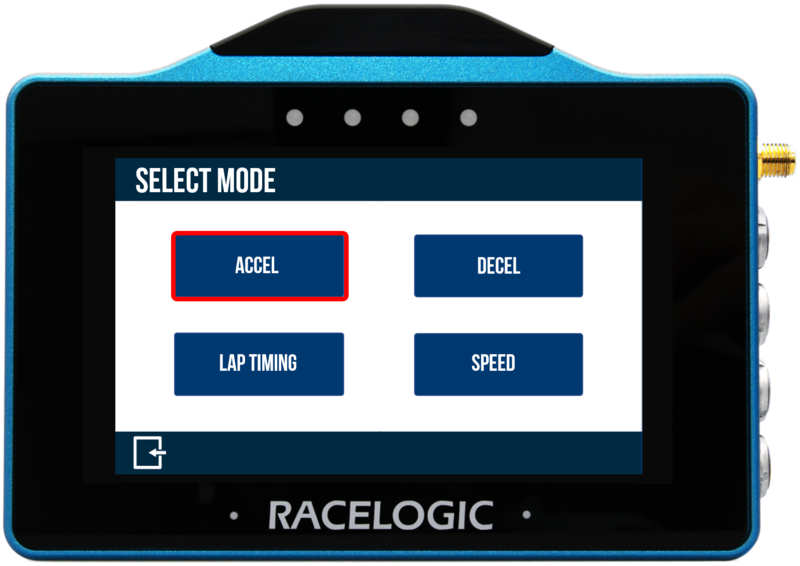
The last selected Acceleration test will be displayed after each power cycle. It is possible to choose from either Speed or Distance parameters to start and end the test. Test results displayed on the screen of the VBOX Touch will remain on screen at the end of the test until the next start condition is met.
Speed units used are dependent on what is selected within the General Settings area.
Note: If the start condition is 0 km/h, VBOX Touch will use the Smoothed Speed Value to reset the test to avoid a test incorrectly resetting within noisy satellite reception areas.
Accel Mode Overview
There are 3 different Acceleration screens which can be accessed by selecting the Forward and Back arrows on the bottom right of the screen or by swiping the screen left or right.
Accel - Primary Screen
This is the default acceleration screen and displays current/completed test information. If One Foot Rollout or Slope Correction is enabled within the Accel Settings, the test header text will reflect the options.
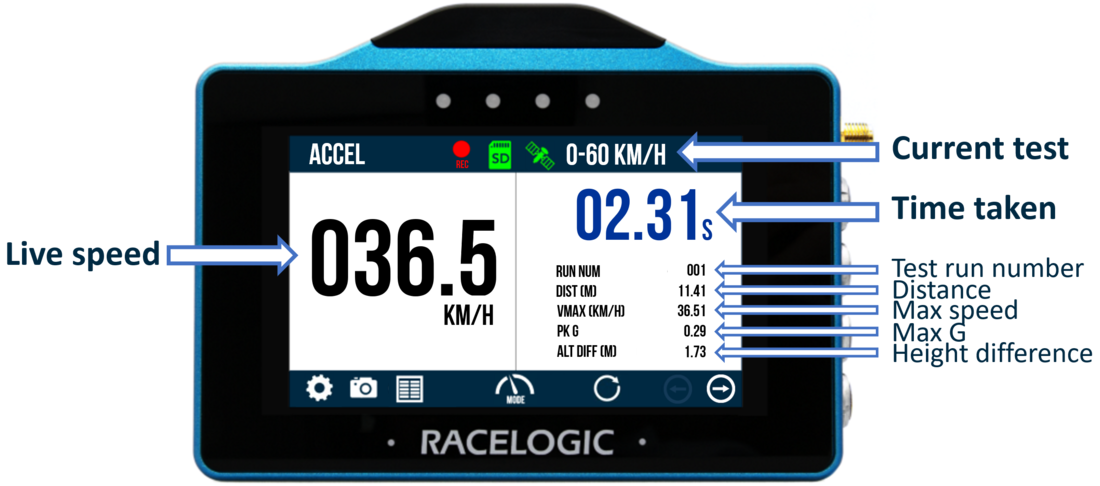
The screen is split in two halves:
- Left hand side: This includes a live speed display which will always show the current speed of the vehicle, irrespective of any test start or end conditions. If the vehicle is traveling less than 0.5 km/h or satellite lock is lost (less than 4 sats), the value will display as 000.0.
- Right hand side: This contains test information: time taken, run number, distance travelled, maximum speed achieved (Vmax), maximum acceleration achieved (g) and height difference. These values will start to populate once the start condition of the test is met. When the end condition is met, they will remain on screen until the start condition is met again. A test can be reset by pressing the Reset button at the bottom of the screen.
Accel - Secondary Screen
This screen displays current test information for all ranges. If One Foot Rollout or Slope Correction is enabled within the Accel Settings, the test header text will reflect the options.
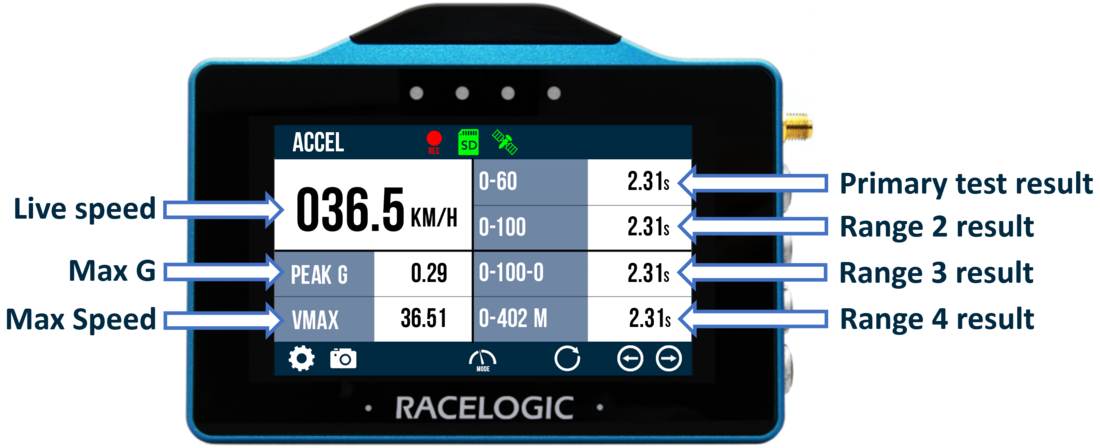
The screen is split in two halves:
- Left hand side: This includes a live speed display which will always show the current speed of the vehicle, irrespective of any test start or end conditions. If the vehicle is traveling less than 0.5 km/h or satellite lock is lost (less than 4 sats), the value will display as 000.0. Maximum acceleration achieved (Peak G) and maximum speed achieved (Vmax) information is also available. These values will start to populate once the start condition of the Primary test is met. When the end condition is met, they will remain on screen until the start condition is met again. A test can be reset by pressing the Reset button at the bottom of the screen.
- Right hand side: This contains results from the defined acceleration test ranges, either as time, distance or speed. These values will start to populate once the start condition of the test is met. When the end condition is met, they will remain on screen until the start condition is met again. Along with pressing the Settings button, Accel tests can also be defined by double tapping on an existing test range header or result.
A test can be reset by pressing the Reset button at the bottom of the screen.
Accel - Best Result Screen
This screen displays best test information for all ranges. If One Foot Rollout or Slope Correction is enabled within the Accel Settings, the test header text will reflect the options.
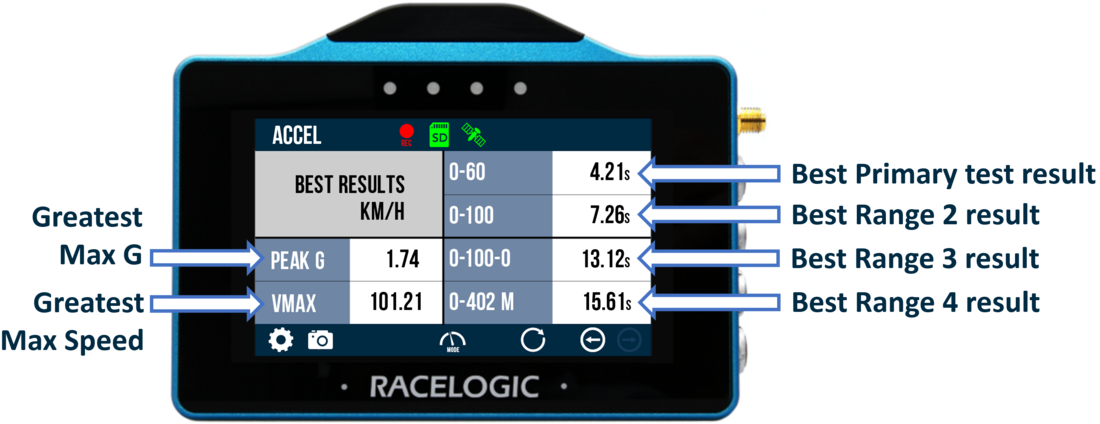
The screen is split into two halves:
- Left-hand side: This includes the maximum acceleration achieved (Peak G) and maximum speed achieved (Vmax) since reset. These values can be reset by pressing the Reset button at the bottom of the screen.
- Right-hand side: This contains the best results from the defined acceleration test ranges, either as time, distance or speed. These values can be reset by pressing the Reset button at the bottom of the screen.
Selecting Accel Tests
Accel Tests can be defined by pressing the Settings button on the bottom left of the screen and then selecting the Accel option. 4 concurrent tests can be defined, which by default are 0–60, 0–100, 0–100–0 and 0–¼ mile.
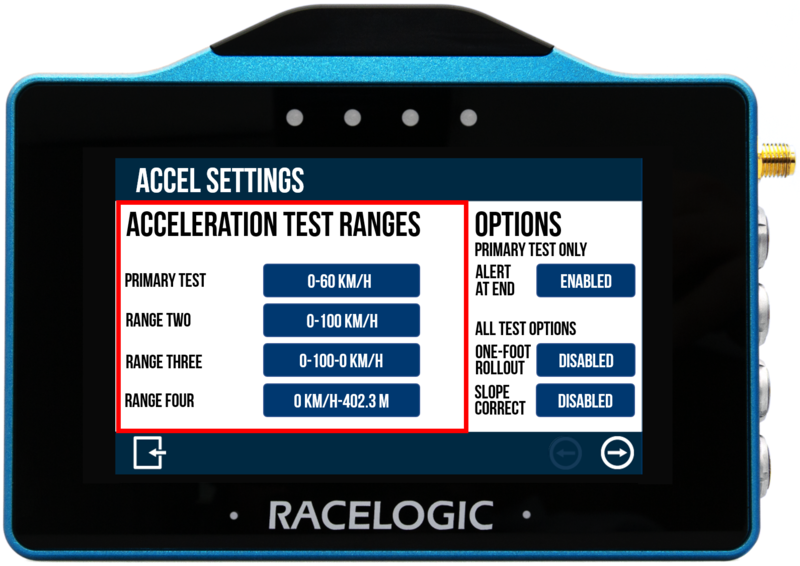
The currently selected test ranges are presented on the left- hand side of the screen and will be remembered for future use, even if another mode is chosen.
To define a range, press on the existing parameters.
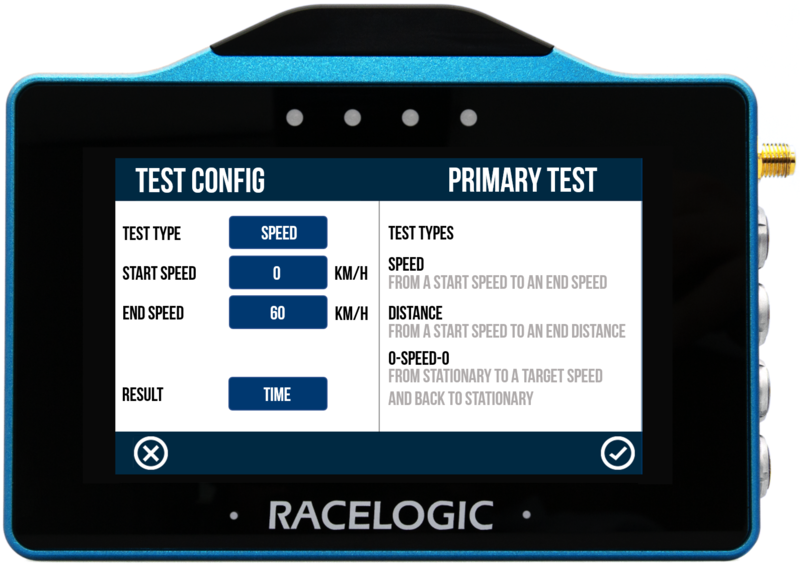
Note: Accel tests can also be defined when in the Secondary Accel Screen by double tapping on an existing test range header or result.
Test Type
Select the Test Type button to choose between Speed, Distance or 0-Speed-0 (e.g. 0–100–0). Parameters displayed will depend on the test chosen.
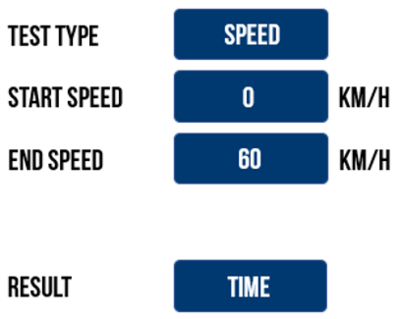 Speed Test Parameters |
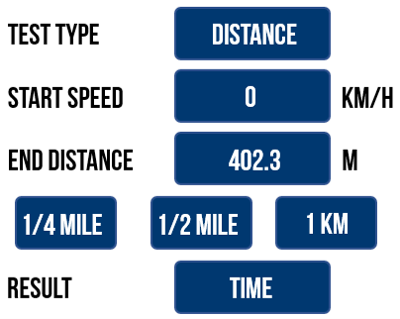 Distance Test Parameters |
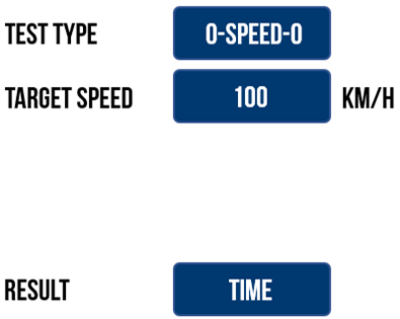 0-Speed-0 Test Parameters |
| Test Type | Parameters | ||
|---|---|---|---|
| Speed | Start Speed (km/h or mph) | End Speed (km/h or mph) | Result (time or distance) |
| Distance | Start Speed (km/h or mph) | End Distance (m or ft) Pre-Set Distance buttons include ¼ mile, ½ mile and 1 km. |
Result (time or speed) |
| 0-Speed-0 | Target Speed (km/h or mph) | Result (time or distance) | |
Start/End Conditions
You can define the start and end conditions by pressing the corresponding buttons and using the keypad presented. If you are defining a Distance test, one of the pre-set distance buttons can be selected to quickly choose the test.

Start Speed Keypad Example
To save the value inputted, press the Confirm Button  on the bottom right of the screen, or press the Cancel Button
on the bottom right of the screen, or press the Cancel Button  on the bottom left of the screen to return to the Custom Test screen without saving.
on the bottom left of the screen to return to the Custom Test screen without saving.
Notes:
- The maximum input value for speed is 999.9 and 9999 for distance.
- The minimum target value for a 0-Speed-0 test is 5 km/h/ 3.1 mph.
- Speed can be entered up to 1 decimal place.
To save the range, press the Confirm Button  on the bottom right of the screen, or press the Cancel Button
on the bottom right of the screen, or press the Cancel Button  on the bottom left of the screen to go back to the Accel Mode screen without saving.
on the bottom left of the screen to go back to the Accel Mode screen without saving.
The parameters of the Primary test is displayed at the top right of the Primary Accel Mode screen. The test ranges will be remembered for future use, even if another mode is chosen.
Result Type
The test result type for a selected test range can be changed by tapping on the current option. Available result types include:
- Speed and 0-Speed-0 tests:
- Time (default) - Elapsed time between start and end conditions being met given as the selected range result.
- Distance - Distance travelled between start and end condition given as the selected range result.
- Distance tests:
- Time (default) - Elapsed time between start and end conditions being met given as the selected range result.
- Speed - Speed when end condition is met given as the selected range result.
Accel Settings
The Accel Mode settings screen can be accessed by selecting the Settings button on the bottom left of the screen and then selecting the Accel option. It enables you to choose the test parameters and also includes other test options. Settings can be changed by pressing on the corresponding button next to an option.
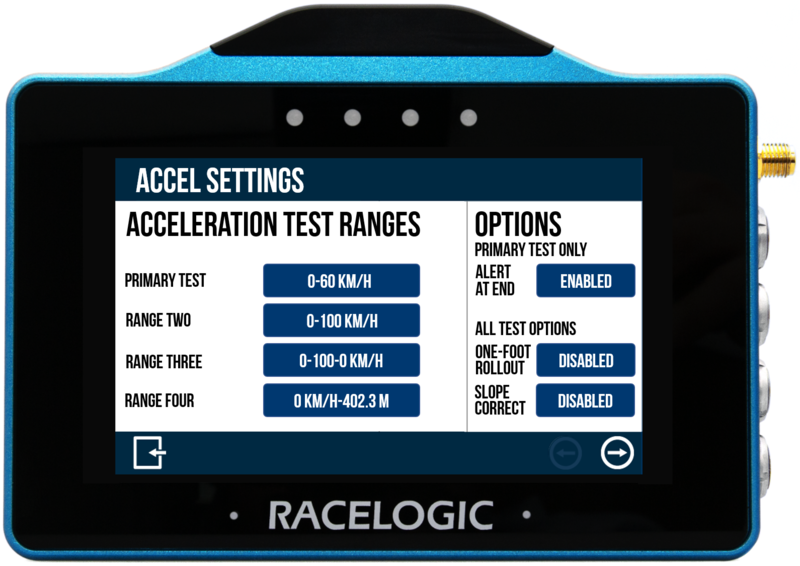
To return to the main screen, select the Exit button on the bottom left.
Alert at End/Target

By default, an audible and visual alert signals when either the test end criteria, or the target speed is met within a 0-Speed-0 test. The VBOX Touch will beep and the 4 LEDs across the top of the device will flash green for 0.5 s. Tap the button to disable.
Note: This setting will only apply to the Primary Test.
One Foot Rollout

If enabled, all tests will not commence until 1 ft or 0.305 m distance has been covered. More information on one-foot rollout can be found here.
Notes:
- Cannot be enabled if Slope Correct is Enabled.
- If Enabled, '1ft' will appear next to the Test header text on the Primary Acceleration Display Screen and 'ONE FOOT ROLLOUT' will be displayed on the right-hand side of the new session header within the Test Results.
Slope Correct

If enabled, VBOX Touch will apply a DB Scanner slope correction method to all speed to speed or speed to distance acceleration test results presented on the screen.
Notes:
- Slope correction only applies to the live display results in order to match DB Scanner third-party software post process corrections. It is not possible to apply post-process corrections using Racelogic software programs.
- Cannot be enabled if One Foot Rollout is Enabled.
- If Enabled, 'DBSC' will appear next to the Test header text on the Primary Acceleration Display Screen and 'DBSCANNER SLOPE CORRECTED' will be displayed on the right-hand side of the new session header within the Test Results.
Screenshot
Selecting the Screenshot button will save a full image of what is shown on the screen to the inserted SD card. If the screenshot has been saved successfully, the LEDs will illuminate yellow in sequence from left to right to display the progress of writing to the SD card. When screen capture is complete, VBOX Touch will emit an audible confirmation notification. If the screenshot has been saved unsuccessfully, for example, no SD card is inserted or the card is full, the SD Card Icon at the top of the screen will flash 3 times and VBOX Touch will emit an audible error notification.
A captured image is saved as a 1.5 MB bitmap image, orientated at 90° to the original screen image, with the prefix 'screenshot'.
IMPORTANT – NEVER remove the SD card when a screenshot is being taken, it could cause the unit to crash!
Test History
A history of the test results can be viewed by selecting the Results button at the bottom of the Primary Accel Screen.
Test results will display until a new test type is chosen or the Reset button is pressed.
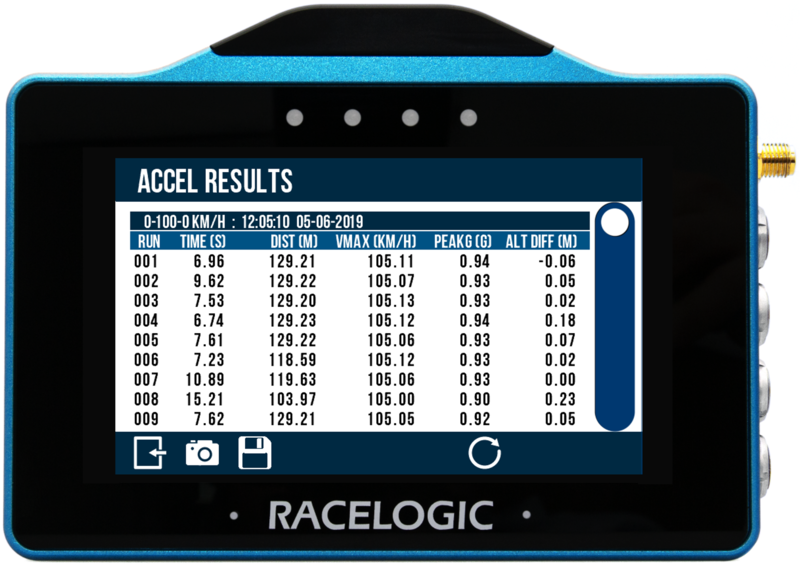
Sample results screen
Tests will be displayed in chronological order and the fastest will be highlighted in green. To scroll through the results, use the scroll bar on the right-hand of the screen.
Each new session will have a separate header, displaying the time and date for the first completed test in that session.
Information includes:
- Test type
- Time of first completed run in session
- Date of first completed run in session
- Test run number
- Test completion time
- Test completion distance (km/h or mph)
- Maximum speed achieved during test run (km/h or mph)
- Maximum acceleration achieved during test run (g)
- Altitude difference between the start of test and end of test (m or ft)
It is possible to take a screenshot of the test history by pressing the Screenshot button.
To return to the main screen, select the Exit button on the bottom left of the screen.
IMPORTANT - Up to a maximum of 127 tests will be displayed in chronological order, however if more tests have been completed, they will still be recorded on the SD card. Once the limit has been reached, a warning message will be briefly shown, advising that further tests will not be saved to the Test History. The message will show again if the unit is power cycled. A 'TEST HISTORY FULL' notification will also be shown beneath the Live Speed display. To view new test history results, press the Reset button.
Save Results
You can also save the results as a .txt or .csv file (dependent on the option selected) to the SD card by selecting the Save button on the bottom of the screen. When pressed, the unit will emit an audible confirmation notification. If the results have been saved unsuccessfully, for example, no SD card is inserted or the card is full, the button will flash 3 times and VBOX Touch will emit an audible error notification.
If saved successfully, the file name will include the test type, the date and also the time, taken from the first completed run in that session. Along with the test history information described above, the results file also includes average acceleration information, as well as the latitude and longitude position (in degrees and decimal degrees format) added to the session header.
Reset
Selecting the Reset button on the bottom right of the screen will reset all test results shown on the current screen. When pressed, the LEDs will briefly flash green twice and the unit will emit an audible confirmation notification.
